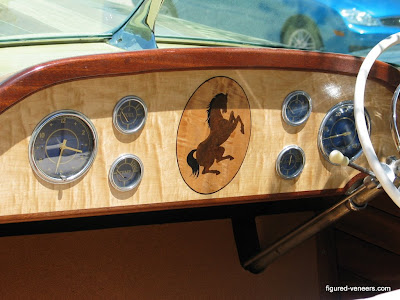French Antique Lois XV Armoire

French Art Deco Period Walnut Buffet
The armoire is from about 1750. The chest of drawers is from about 1800. I guess you can't say that veneered furniture won't hold up. They seem to be doing pretty well considering they have been around longer than electricity, flushing toilets, and in one case our country.
As for what you can find for veneered furniture and the like today, I'll start with a few of my own pieces. In these cases, I am using a man made substrate covered with a real wood veneer. We will talk about those man made materials in another blog post; believe me, I plan on bringing it up. They have their place and have their advantages if used appropriately. That being said, let's not rabbit track too far away from our original topic and save that for another day.
The face of this clock is made with Sapelle veneer that has a pommel figure to it. The rest of the clock is covered in mahogany.
While the base and feet of this clock are made of solid wood, the half round section is veneer all the way. It is covered in walnut and the cheeks are the same pommel sapele wood that you saw above.
Like the first clock. This is all veneer. Except this time the face is a walnut burl and the rest is walnut.
While the sides of this box are solid Honduran mahogany, the top and bottom are baltic birch plywood covered with a veneer. The top here is done with a curly mahogany.
Like the other box, the sides are solid wood. In this case it is koa. Also like the other box, the top and bottom are veneered baltic birch plywood. The top on this box is covered in quilted bubinga.
Now I have to admit, comparing those large pieces of furniture to my my smaller works does seem a bit like comparing apples to oranges. Frankly, I haven't gotten to veneering much in my larger work. Luckily for us though Bill Kimbell of figured-veneers.com agreed to come to the rescue. He's a woodworker with about 25 years of experience and happens to live a bit north of me. He sent me some pictures of some of his work and may be giving us some of his thoughts here in the future. Until then, take a look at some of the stuff he has done.
This table uses 8 pieces of walnut burl veneer to form the center of the table. Around the center you can see where he has cut smaller veneer circles as a border around it. There are over 400 of the those circles in all.
You can use veneer for outdoor projects as well. I have seen veneered cars before. In this case, Bill veneered the dashboard for a 22 foot boat.
The table top here is made from book matching 2 pieces of crotch cherry and is bordered with Koa. All of the leaves, flowers, and veining is veneer as well using a technique called marquetry.
Here is a close up of the edge of a mahogany demilune table he built. The black parts denoting the feet of the table? Veneer. The fabulous mahogany apron? Veneer. It also has some brilliant marquetry and banding too.
This table is one of a pair that he made. It is a reproduction of the tables found in the state room of the SS Normadie, which was launched in 1932.
I have to admit, I had a hard time picking my favorite picture of this table. This is an art nouveau desk with some really beautiful lines and marquetry on the front. I decided on the picture of the top though showing the book matched tamo ash top and the hand cut banding.
So, there's the good. We've already talked about the bad and the ugly. I didn't think you really needed pictures of it. Up next, what is veneer. We will also go into how and why it is used. Until then, I should probably leave you with some sort of witty comment. Unfortunately, I haven't thought of a good one.















No comments:
Post a Comment